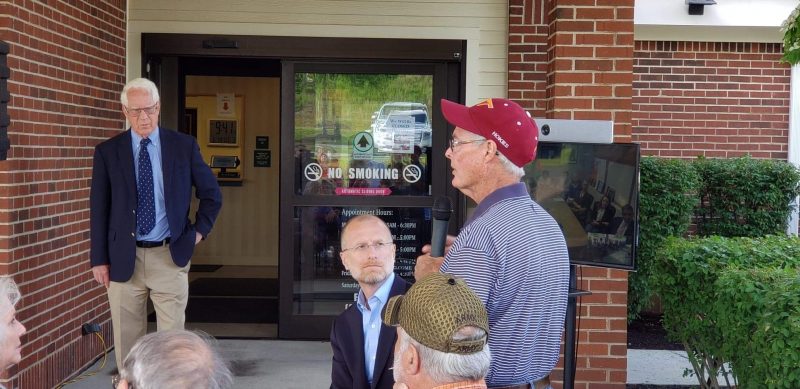
By Debbie Hall
Plans are underway to advance a $100 million Connected Care Pilot Program to support telehealth for low-income Americans, including those living in rural areas and veterans, according to FCC Commissioner Brendan Carr.
The pilot program “is a new step we’re taking to expand telehealth care. We’re seeing a trend in telehealth towards connected care everywhere,” Carr said Wednesday at the Tri-Area Community Health Center in Laurel Fork, where he announced the Federal Communication Commission will seek to establish the new program.
Telehealth “is the future,” Carr said. “We’re still stuck in a Blockbuster world of delivering healthcare and we’ve got to move to Netflix.”
“The FCC has long supported the deployment of broadband to healthcare facilities, but advances in technology mean that high-tech, life-saving services are no longer limited to the confines of connected, brick-and-mortar facilities,” Carr said.
“All Americans should have access to high quality health care,” Carr said, adding that the diabetes level in the rural area is a third higher than the national average, while income levels are about a third lower than the national average.
Carr said he visited Mississippi six months ago “and learned about a remote patient monitoring trial that improved outcomes for diabetes patients living in the rural Mississippi Delta. Since then, my office has been meeting with experts in this field, visiting rural health care facilities, and working to see how the FCC can support this movement towards connected care.
“It’s difficult to impossible to find specialists in rural communities. We’re using telehealth to bring specialists to the heart of Appalachia,” he said. That way, when patients leave the medical office, “their access to patient care doesn’t have to drop to zero.”
Carr selected the Tri-Area Community Health Clinic to make the announcement, partly because the clinic currently works with the UVA Health System to offer diabetes education classes to patients having trouble controlling their A1c levels. Participating patients may be provided with devices that automatically measure the levels. The device then uploads the results into the cloud, where medical staff access the information and use it to better help the patient.
Other speakers included Dr. Richard “Dick” Santen, professor, Diabetes and Endocrine Clinic at UVA; Dr. Karen Rheuban, professor of pediatrics and senior associate dean for continuing medical education and external affairs at the School of Medicine; and Howard Chapman, director of programs and development at Tri-Area Community Health Centers.
“The innovative work being done here is already delivering results,” Carr said, but noted it would not be possible without broadband connectivity in homes.
UVA also plans to provide a telehealth program to veterans. “Clinics like UVA can feel far away” to those in rural areas, he said, adding the FCC “can help support programs like this.”
Telehealth programs also result in savings and better outcomes for patients, he said.
For instance, a Mississippi Delta trial resulted in nearly $700,000 in annual savings due to reductions in hospital readmissions alone. Assuming just 20 percent of Mississippi’s diabetic population enrolled in this program, Medicaid savings in the state would be $189 million per year, he said.
The Veterans Health Administration’s (VHA) remote patient monitoring program cost $1,600 per patient compared to more than $13,000 per patient for VHA’s home-based primary services, he added.
A telehealth project in the Northeastern U.S. found that every $1 spent on remote monitoring resulted in a $3.30 return in savings, Carr said.
The connected care technologies also improve health outcomes for patients, Carr said, adding that a study of 20 remote patient monitoring trials found a 20 percent reduction in all-cause mortality and a 15 percent reduction in heart failure-related hospitalizations.
The VHA’s remote patient monitoring program resulted in a 25 percent reduction in days of inpatient care and a 19 percent reduction in hospital admission.
One remote patient monitoring initiative showed a 46 percent reduction in ER visits, a 53 percent reduction in hospital admissions and a 25 percent shorter length of stay.
“Given the significant cost savings and improved patient outcomes associated with connected care, we should align public policy in support of this movement in telehealth,” Carr said. “At the FCC, we can play a constructive role by helping to support the connectivity and deployments needed to ensure that all communities get a fair shot at benefiting from new telehealth technologies. I look forward to working with my colleagues at the FCC, federal and state partners that are active on these issues, and all stakeholders as we seek comment on establishing the Connected Care Pilot Program. We need your feedback, particularly to make sure we’re targeting the right audience,” Carr said.
Ninth District U.S. Rep. Griffith, R-Salem, said “Telehealth can bring more health care access and choice to rural areas. The FCC’s support for telehealth through the Connected Care Pilot Program will help health care providers reach more patients at a lower cost. It is fitting that Commissioner Carr made this announcement in Laurel Fork, as the people of Southwest Virginia stand to benefit from telehealth initiatives such as the Connected Care Pilot Program.”
The FCC will vote on a Notice of Inquiry at its August Open Meeting that seeks comment on budgeting for $100 million in USF (Universal Service Fund) support; targeting support to connected care deployments that would benefit low-income patients, including those eligible for Medicaid or veterans receiving cost-free medical care.
If approved, the funds will support a limited number of projects over a two- or three-year period with controls in place to measure and verify the benefits, costs, and savings associated with connected care projects.






